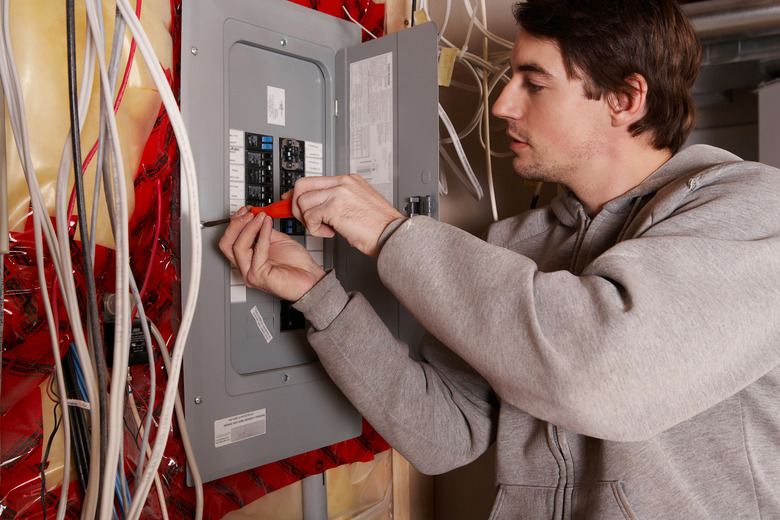How To Determine What Size Breaker Box I Need
The size of your breaker box tells you how many electrical appliances or fixtures can run at the same time. If you live in an all-electric home, you will need a larger breaker panel than if the structure used a combination of electricity and gas. Your needs also depend on the types of appliances you use. Computers and stereo systems need very little power, while electric ranges and electric heat require a lot of juice, according to Global HR News.
Step 1
Multiply the square footage of your home by 3 to determine the light and receptacle watts needed. For example, if your home's square footage equals 1,650 square feet, multiply that number by 3 for a total wattage need of 4,950 watts (1,650 x 3 = 4,950).
Step 2
Add the wattage needs for the kitchen. You need a small-appliance, 20-amp single-pole circuit for the kitchen. Multiply 20 amps by 120 volts for a total of 2,400 watts. Your total wattage now equals 7,350 (2,400 + 4,950 = 7,350). A single-pole breaker operates at 120 volts while a double-pole breaker operates at 220 volts.
Step 3
Add the wattage of any dedicated kitchen circuits. The electric range uses a 50-amp double-pole dedicated breaker. Multiply 50 amps by 220 volts for a total of 11,000 watts. The dishwasher needs a 20-amp single-pole dedicated circuit. Multiply 20 amps by 120 volts for total of 2,400 watts. Your total wattage now equals 20,750 (7,350 + 11,000 + 2,400 = 20,750).
Step 4
Add the wattage of the dedicated laundry room circuits. The dryer uses a 30-amp double-pole dedicated breaker. Multiply 30 amps by 220 volts for a total of 6,600 watts. The washer needs a 20-amp single-pole dedicated breaker. Multiply 20 amps by 120 volts for a total of 2,400 watts. Your total wattage now equals 29,750 (20,750 + 6,600 + 2,400 = 29,750).
Step 5
Calculate your wattage needs before adding your central air-conditioning and heating unit. The first 10,000 watts of your total must be calculated at 100 percent, as per the National Electrical Code (NEC). The balance of the wattage (19,750) is calculated at 40 percent, as per the NEC. Forty percent of your remaining wattage equals 7,900 watts (19,750 x .40 = 7,900). Your total wattage now equals 17,900 (29,750 – 10,000 = 19,750 x .40 = 7,900 + 10,000 = 17,900).
Step 6
Calculate the wattage needs of your central air conditioner and heating unit. The central air conditioning and heating unit runs on a 60-amp double-pole dedicated breaker. Multiply 60 amps by 220 volts for total wattage of 13,200 (30 x 220 = 13,200).
Step 7
Add the total watts of 17,900 to the total air conditioning and heating watts of 13,200 for a final total wattage of 31,100 (17,900 + 13,200 = 31,100).
Step 8
Divide the total wattage by 230, as per the NEC, for total amperage of 135.2173 (31,100 / 230 = 135.2173). Your main circuit panel should equal 150 amps. Residential main breaker panels are available in four sizes, 100 amps, 125 amps, 150 amps and 200 amps. Round up your total amperage number to the nearest panel size.
References
- "National Electrical Code 2008": National Fire Protection Association: 2007
- "Wiring 1-2-3"; Steve Cory; 2005
